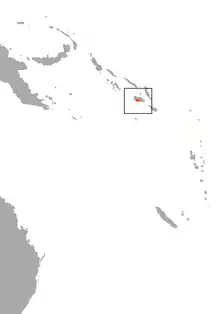| Montane monkey-faced bat | |
|---|---|
| Scientific classification | |
| Domain: | Eukaryota |
| Kingdom: | Animalia |
| Phylum: | Chordata |
| Class: | Mammalia |
| Order: | Chiroptera |
| Family: | Pteropodidae |
| Genus: | Pteralopex |
| Species: | P. pulchra |
| Binomial name | |
| Pteralopex pulchra Flannery, 1991 | |
 | |
| Montane monkey-faced bat range | |
The montane monkey-faced bat or montane flying monkey (Pteralopex pulchra) is a megabat endemic to the Solomon Islands. It is listed as a critically endangered species.[1] Due to its imperilled status, it is identified by the Alliance for Zero Extinction as a species in danger of imminent extinction.[2] In 2013, Bat Conservation International listed this species as one of the 35 species of its worldwide priority list of conservation.[3] Only one individual has ever been found.[1]
Taxonomy and etymology
It was described as a new species in 1991 by Australian mammalogist Tim Flannery. The holotype was collected in May 1990 on Mount Makarakomburu, which is on Guadalcanal Island. Its species name "pulchra" is from Latin pulcher 'beautiful'.[4]
Description
It is the smallest member of its genus. The holotype weighed 280 g (0.62 lb). The length of its head and body together is 161.8 mm (6.37 in). Its forearm is 117.9 mm (4.64 in) long. Its ears are short and narrow, at 16.8 mm (0.66 in) long. Like other monkey-faced bats, it wings attach to the body near the spine rather than at the sides of its body, it has a defined sagittal crest, and it has massive canine teeth. It has "striking" red eyes. Its flight membranes are black and white. Its head, face, and back is blackish in color. The fur on its ventral side is yellowish. The ears are black, while the fur at the base of each ear is white.[4] Like other members of its genus, its dental formula is 2.1.3.22.1.3.3.[5] Flannery called it the "most attractive" member of its genus due to its striking coloration.[4]
Biology
As only one individual has been encountered, little is known about its biology. The holotype was a lactating female encountered in May.[4] Pteralopex is a very old genus of bats, and the monkey-faced bats evolved in relative isolation to fill ecological niches occupied by large mammals in continental ecosystems.[6]
Range and habitat
It is thought to occur in montane forests above 1,200 m (3,900 ft) above sea level.[5] So far, it has only been documented in the high-elevation forests of the island of Guadalcanal in the Solomon Islands.[1]
Conservation
It is assessed as critically endangered (possibly extinct) by the IUCN. If it is not extinct, the IUCN estimates that its population contains no more than 50 adults in a single population. Extensive surveys in 2015 failed to locate additional individuals, making the holotype collected in 1990 the only documented individual.[1] In 2010, the United States Federal Government received a petition from WildEarth Guardians to list the montane monkey-faced bat, as well as 14 other species of bat, under the Endangered Species Act.[7] It is still under review for consideration under the Endangered Species Act.[8]
Scientist Diana Fisher coauthored a paper on the probability of rediscovering mammal species that have not been documented in several years, including the montane monkey-faced bat.[9] Later, in an interview, she noted that several species of mammal feared extinct had a decent chance of rediscovery, specifically mentioning the montane-monkey faced bat and Alcorn's pocket gopher.[10] In particular, Fisher and coauthor Blomberg found that time missing was an important factor in mammal rediscovery, with species that haven't been missing as long more likely to be rediscovered. Mammals with larger ranges are also more likely to be rediscovered after "extinction," as well as mammals thought to have gone extinct due to habitat loss as opposed to overhunting.[9]
In 2015, the nonprofit organization Bat Conservation International awarded a Grassroots Grant to Australian researchers to confirm where surviving populations exist.[11] However, the holotype is still the only known example of this species.
References
- 1 2 3 4 5 Lavery, T.H. (2018) [amended version of 2017 assessment]. "Pteralopex pulchra". IUCN Red List of Threatened Species. 2018: e.T18658A128950188. doi:10.2305/IUCN.UK.2018-1.RLTS.T18658A128950188.en.
- ↑ "A Five-Year Plan for Global Bat Conservation" (PDF). batcon.org. Bat Conservation International. October 2013. Archived from the original (PDF) on April 17, 2018. Retrieved May 1, 2017.
- ↑ "Annual Report 2013-2014" (PDF). batcon.org. Bat Conservation International. August 2014. Archived from the original (PDF) on July 7, 2017. Retrieved May 1, 2017.
- 1 2 3 4 Flannery, Tim F (1991). "A new species of Pteralopex (Chiroptera: Pteropodidae) from Montane Guadalcanal, Solomon Islands" (PDF). Records of the Australian Museum. 43 (2): 123–129. doi:10.3853/j.0067-1975.43.1991.44.
- 1 2 Helgen, Kristofer M (2005). "Systematics of the Pacific monkey‐faced bats (Chiroptera: Pteropodidae), with a new species of Pteralopex and a new Fijian genus". Systematics and Biodiversity. 3 (4): 433–453. doi:10.1017/S1477200005001702.
- ↑ Lavery, Tyrone (20 May 2016). "Walking in the footsteps of giants". Australian Museum. Australian Museum. Retrieved 4 March 2018.
- ↑ "Review of Petition To List 15 Bat Species as Endangered or Threatened Under the Act" (PDF). Federal Register. 79 (14). 22 January 2014.
- ↑ "Species Profile for Montane Monkey-Faced Bat (Pteralopex pulchra)". Environmental Conservation Online System. U. S. Fish & Wildlife Service. Retrieved 3 March 2018.
- 1 2 Fisher, D. O; Blomberg, S. P (2010). "Correlates of rediscovery and the detectability of extinction in mammals". Proceedings of the Royal Society B: Biological Sciences. 278 (1708): 1090–1097. doi:10.1098/rspb.2010.1579. PMC 3049027. PMID 20880890.
- ↑ Switek, Brian (29 September 2010). "A Third of 'Extinct' Mammals May Still Be Alive". Wired. CNMN Collection. Retrieved 4 March 2018.
- ↑ "BCI awards Grassroots Grants for 2015". BatCon.org. Bat Conservation International. 4 October 2015. Retrieved 4 March 2018.
